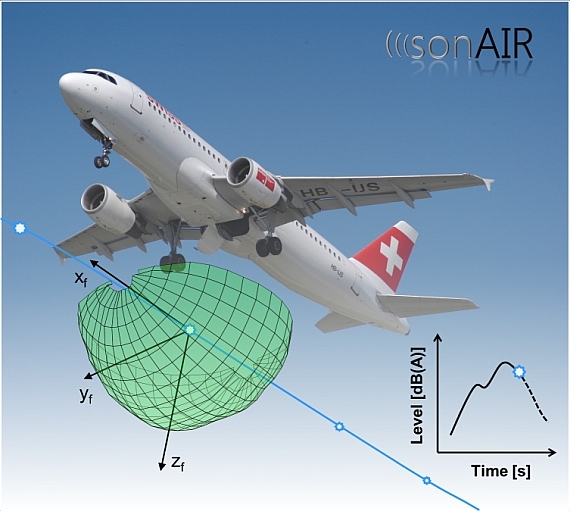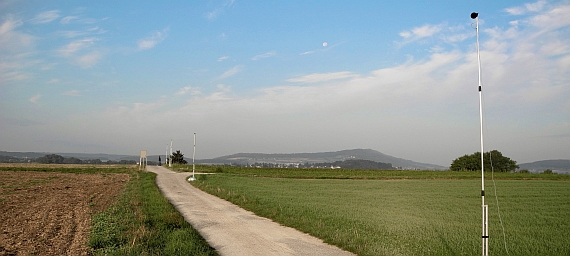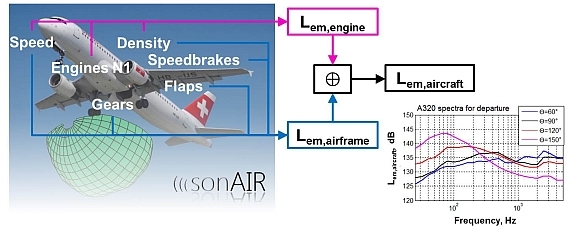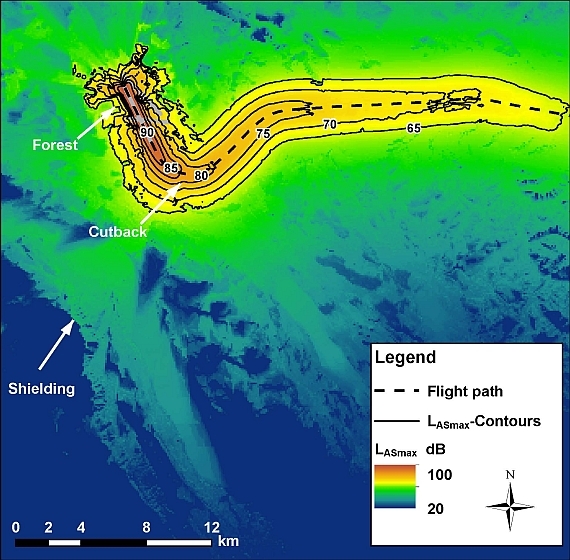sonAIR
sonAIR is an aircraft noise calculation model that has been developed at the laboratory for Acoustics / Noise Control of Empa between 2012 and 2016 and which is being constantly actualized. The model comprises of a source model describing in detail the sound emission and directivity as a function of flight configuration (power setting and aeroplane configuration, i.e., flaps, slats and landing gear). The source model is combined with the highly developed sound propagation model sonX of Empa. Individual flights are simulated according to a time-step procedure. The resulting aircraft noise calculation model is able to reliably predict noises levels even in greater distances from the airport. In addition, the model can be applied for the development of noise abatement operational procedures and thus contribute to a minimization of entailed annoyance during the day, sleep disturbance during the night, and finally of noise-induced costs.

Acoustical measurements and aircraft parameter
An extensive acoustic measurement of real air traffic in the close vicinity and at large distances of Zurich airport was carried out in the years 2013 and 2014. The measurements covered the major large aircraft types operating in Switzerland. In total 2‘600 overflights in the close range of the airport, each recorded on eight different microphone locations, and 11‘000 overflights in the far range of the airport at ten different locations from Pfannenstiel to Winterthur as well as Bellikon (Aargau) have been recorded.
To develop the sound source model, cockpit data – which were available in this project for Swiss and Edelweiss flights – yield an ideal data basis to connect the acoustic measurements with the actual flight condition. For aircraft of other airline companies, an optical tracking system was used in the close vicinity of the airport to complement radar data. Further, a special analysis procedure to determine the low compressor speed of starting and landing aircraft was applied.

Source Model
To establish the source model the measured spectra were propagated back to the source and connected to the corresponding flight conditions. Thereby, propagation time, the Doppler shift (frequency as well as intensity) and also all important propagation phenomena such as the ground effect and vertical stratification of the atmosphere in terms of temperature, humidity, wind and air pressure were taken into account.
In the dissertation of C. Zellmann a method was developed to divide the empirical data into two separated source models, namely the engine and airframe noise model. The most important parameters for both approaches were identified and applied to each aircraft type. Finally, the energetic sum of the engine and airframe noise model adds up to the directional sound power level as a function of the flight configuration.

Simulation

Status
sonAIR was developed as a research tool and will constantly be further developed for that purpose. In parallel an implementation of sonAIR in a geographic information system GIS is currently done in collaboration with the company n-Sphere AG. This tool shall in the future be made available for a broader group of users.
Funding
sonAIR was funded within the Special Financing of Civil Aviation by the Federal Office of Civil Aviation (FOCA). Additional funding was provided by Empa, Flughafen Zürich AG, Aéroport International de Genève (AIG), Office of Transport of the Canton of Zurich (AFV), as well as skyguide within the framework of CHIPS. Partners within the initial sonAIR project were the companies SciTracks GmbH for the mobile optical flight path tracking system and BeSB GmbH Berlin for the determination of the low compressor speed. Funded by the Federal Office for the Environment (FOEN) and in collaboration with the company n-Sphere AG, the new aircraft noise calculation model is being implemented in a geographic information system GIS.
References:
Wunderli J. M.; Zellmann C.; Köpfli M.; Habermacher M.; Schwab O.; Schlatter F.; Schäffer B. (2018). "sonAIR - a GIS-Integrated Spectral Aircraft Noise Simulation Tool for Single Flight Prediction and Noise Mapping", Acta Acustica united with Acustica, Vol. 104 (2018) 440-451
Zellmann C., Schäffer B., Wunderli J. M., Isermann U., Paschereit C.O. (2017).
„Aircraft Noise Emission Model Accounting for Aircraft Flight Parameters”, Journal of Aircraft (2017), accessed September 09, 2017. doi: https://arc.aiaa.org/doi/abs/10.2514/1.C034275
Zellmann C., Wunderli J. M., Paschereit C.O. (2016). „The sonAIR sound source model: spectral three-dimensional directivity patterns in dependency of the flight condition”, INTER-NOISE 2016 - 45th International Congress on Noise Control Engineering: Towards a Quieter Future; Hamburg, p. 786-94.
Zellmann C., Wunderli J. M. (2014). „Influence of the atmospheric stratification on the sound propagation of single flights”, INTER-NOISE 2014 - 43rd International Congress on Noise Control Engineering: Improving the World Through Noise Control; Melbourne.
Zellmann, C., Wunderli J. M. and Schäffer B. (2013). „SonAIR - Data acquisition for a next generation aircraft noise simulation model.” 42nd International Congress and Exposition on Noise Control Engineering 2013, INTER-NOISE 2013: Noise Control for Quality of Life.
Schäffer, B., Zellmann C., Krebs W., Plüss S., Eggenschwiler K., Bütikofer R. and Wunderli J. M. (2012). „Sound source data for aircraft noise calculations – state of the art and future challenges.” Proceedings of Euronoise 2012, Ninth European Conference on Noise Control, Prague, Czech Republic, pp. 589-594

-
Share
